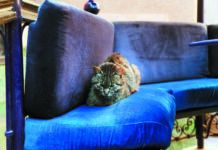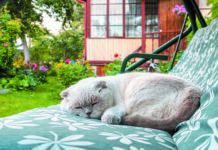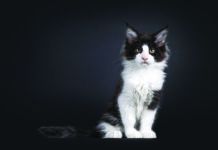Cats have an uncanny ability for sizing up their surroundings — through their noses. While our noses have 5 million odor sensors, theirs have as many as 200 million. Put into practical terms, what we can smell from 10 feet away, they can smell from a distance of 140 feet; they know what they’re getting for breakfast the second you start pulling back the pop top on the lid.
But there’s more. Cats have an organ we lack that allows them to smell pheromones, chemicals that signal the presence of other cats. Called the vomeronasal organ, it lets them know whether other cats have been on or near their territory, whether you’ve petted another cat, and whether a cat wants to mate. The vomeronasal organ sits at the roof of the mouth. It’s the reason cats open their mouths when they want to smell something.
Detecting the pheromones of a cat that has been in the vicinity but is no longer present is the feline equivalent of knowing that someone has been in the room because they left their purse, or their wallet. What we divine by sight, they figure out by scent. It’s why cats are always rubbing up against things — and you — with their faces and bodies. They are leaving indications that they have been there. Often, they are also leaving a message that what they have rubbed against is theirs. Scratching leaves olfactory messages, too.
A cat’s sense of smell is so critical to her understanding of her surroundings and her emotional comfort that providing an environment that respects a cat’s olfaction is one of the five pillars of a healthy feline environment, according to the American Association of Feline Practitioners and the International Society of Feline Medicine. We touched on those pillars in the June 2022 issue of Catnip, but this one requires some delving into for you to best tend to your cat’s needs. The steps to take are so easy, but they’re also so easy to miss due to the fact that our cats live in an olfactory world of which we are only dimly aware.
To allow a cat to feel comfortable with what she smells in her environment rather than threatened:
- When you bring a new item into your home, expose it to your cat’s scent profile by rubbing it with a cloth that has been in contact with her scent glands during positive interactions with you. Maybe the new item is a piece of furniture and the cloth is a sweater you often wear when engaging in nice quiet time with your pet. You can also spray the new item with a synthetic feline pheromone.
- Wash your cat’s bedding or other paraphernalia on a rotating basis. That way, at least some of her stuff will always retain her own scent. It’s called olfactory continuity.
- If your cat is able to come in and out of your house so she can relax in a fenced-off outdoor space at will, consider installing a door that “recognizes” her via a microchip ID and opens electronically. That way, other animals and their scents — which can last long after you send the visitor packing — will not be able to enter. The pet door will open only for your cat.
- Be aware that a cat who has been to the veterinarian’s office will be perceived by a companion cat who stayed home as reeking of other animals, not to mention medications, antiseptics, and cleaners. A cat can even smell the post-operative gasses of anesthesia. It may make her extremely aggressive toward the cat she now considers a newcomer because the cat’s regular scent has been disguised. If possible, take all your cats to the vet at the same time to avoid nasty reintroductions. If that’s not possible, consider placing a synthetic pheromone diffuser in the house to help maintain the existing scent profile as best as possible.
- Take off your shoes as soon as you come home. Why make your pet adjust to all the foreign scents wafting through the rooms as you move about?
- Avoid scented cleaning agents, as well as scented litter. They create too much olfactory “static” when your cat is most comfortable in a stable olfactory environment.





Interesting
I love when cats do “open mouth sniffing.” Once I brought in a table that had been left outside-it was a cat frenzy!